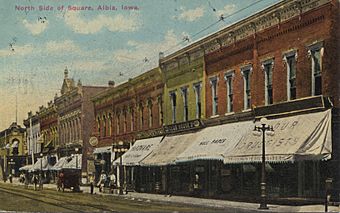Albia Square and Central Commercial Historic District facts for kids
Quick facts for kids |
|
|
Albia Square and Central Commercial Historic District
|
|

Historic postcard image of the north side of the town square
|
|
| Location | Roughly bounded by the alley of S. and N. Clinton, E. and W. A Ave., N. and S. 2nd St., and E. and W. 2nd Ave., Albia, Iowa |
|---|---|
| Architectural style | Italianate Queen Anne |
| NRHP reference No. | 85000007 |
| Added to NRHP | January 3, 1985 |
The Albia Square and Central Commercial Historic District is a special area in Albia, Iowa, United States. It includes most of the main shopping and business area of the town. This district was officially recognized and added to the National Register of Historic Places in 1985.
This historic area has 92 important buildings from the late 1800s and early 1900s. These buildings help tell the story of Albia's past.
Contents
Discovering Albia's Historic Town Square
The Albia Square and Central Commercial Historic District is like a time capsule. It shows how towns in Iowa looked and functioned long ago. This area is important for understanding the history of Albia.
What is a Historic District?
A historic district is a group of buildings, structures, or sites that are important together. They are important because of their history, architecture, or culture. When a place is listed on the National Register of Historic Places, it means it's a significant part of American history.
The buildings in Albia's district are called "contributing properties." This means they add to the historical feel and importance of the area. They show the architectural styles popular in the late 19th and early 20th centuries. You can see styles like Italianate and Queen Anne in these buildings.
Why Preserve Historic Places?
Preserving historic places helps us remember the past. It teaches us about how people lived and worked. It also helps keep the unique character of a town alive. These places are valuable for future generations to learn from.
Operation Facelift: Making Albia Beautiful
In 1965, a newspaper story described Albia in a way that inspired change. Robert T. Bates, who was a leader at First Iowa State Bank, decided to act. He started a project called "Operation Facelift."
Bates was a talented interior designer. He had worked in Hollywood before coming back to Albia in the 1950s. He wanted to make Albia's town square look its best.
How the Community Helped
Many people in Albia joined "Operation Facelift." Volunteers asked building and business owners for a small donation. This money helped start the project. It showed how much the community cared about their town.
Robert T. Bates also showed his dedication. He set up a large fund to help with future improvements. This helped make sure the revitalization efforts could continue for many years. This project helped make Albia's historic district a place to be proud of.



